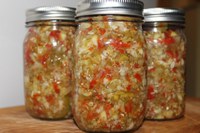Prairie Fare: Ovens Are for Baking, Not Canning, and Other Food Preservation Tips
(Click an image below to view a high-resolution image that can be downloaded)
By Julie Garden Robinson, Food and Nutrition Specialist
NDSU Extension Service
In the past few weeks, I fielded questions for some of our North Dakota Extension agents while they took well-earned annual leave. I learned a lot about what people do as they harvest their bountiful garden produce.
As the questions reached my office, I also began exploring the internet to see what was being shared by some blogs, Pinterest, Facebook and websites.
Some of the questions and information I found online surprised me. Some frightened me. Some of my callers had found their information on questionable sites.
Always proceed cautiously with food preservation information you find online; it’s not all safe.
Here are some tips to remember: Ovens are for baking food, but not for canning. Dishwashers are for washing dishes and canning jars, but not sealing canning jars. Microwave ovens are for heating foods and beverages quickly, but not canning foods.
A friend of mine told me that some people are sealing jars in bathtubs, but I couldn’t find that online. Maybe she was pulling my leg. Just in case, I’ll add another tip: Bathtubs are for bathing, not sealing canning jars. “Boiling water baths” are a method for canning acidic foods and the method is done on a stovetop, not in your bathroom.
Why would some of this information scare me? Botulism, one of the deadliest types of foodborne illness, is caused by eating improperly canned food, especially home-canned food. Commercial canners are extremely cautious about their canning procedures, but they have occasional safety recalls due to a botulism risk, too.
If you have bountiful tomatoes, be sure to add the recommended amount of lemon juice or citric acid before canning because the acidity of tomatoes can vary, depending on where they were grown and the variety. Don’t invent a salsa recipe and expect it to be safe for canning; freeze your inventions and use research-tested recipes for your canned goods.
Vegetables and meats are low-acid foods, meaning they do not contain enough acid naturally to prevent spores (forms of bacteria) from surviving and growing. Spores can produce a deadly toxin in an airtight environment, such as a sealed jar, unless the food is acidic or has been heated under pressure for a specified time.
Boiling food will not kill the spores. For safe canning of low-acid foods such as green beans, corn, carrots and most mixtures of foods, a pressure canner must be used. Using a pressure canner allows the mixture to reach a higher temperature than a boiling water-bath canner.
Unfortunately, foods containing the botulism toxin usually do not have an unusual taste or appearance. You cannot tell it is there. Blurred and double vision are hallmark signs of botulism. Besides vision problems, slurred speech, difficulty swallowing and muscle weakness can occur 18 to 36 hours after eating foods contaminated with the toxin.
Without treatment, the illness can progress from head to feet, weakening muscles and potentially paralyzing your respiratory system. Death can occur without prompt treatment.
I probably have scared all of my readers by now. However, I assure you that safe home canning is entirely possible. You just need to follow carefully the latest instructions from credible sources such as university websites or the National Center for Home Food Preservation.
When you are canning food, such as tomatoes, salsa and green beans, think of yourself as a chemist and physicist. Measure accurately, and follow the directions, processing times and methods exactly.
If someone offers you some home-canned goods, don’t be shy about asking the person how the food was prepared. Visit https://www.ag.ndsu.edu/food for the research-tested information about canning, freezing or drying fruits and vegetables, and making jelly, sauerkraut and wine. Click on “Food Preservation” for free information.
If you have some cucumbers, peppers and onions, make your own tasty relish with this recipe developed by the U.S. Department of Agriculture.
Sweet Pickle Relish
3 quarts chopped cucumbers
3 c. chopped sweet green peppers
3 c. chopped red peppers
1 c. chopped onions
3/4 c. canning or pickling salt
4 c. ice
8 c. water
2 c. sugar
4 tsp. each of mustard seed, turmeric, whole allspice and whole cloves
6 c. white vinegar (5 percent)
Add cucumbers, peppers, onions, salt and ice to water and let stand four hours. Drain and re-cover vegetables with fresh ice water for another hour. Drain again. Combine spices in a spice or cheesecloth bag. Add spices to sugar and vinegar. Heat to boiling and pour mixture over vegetables. Cover and refrigerate 24 hours. Remove spice bag. Heat mixture to boiling and fill into clean, hot jars, leaving 1/2 inch head space. Process in a boiling water-bath canner 10 minutes at 0 to 1,000 feet altitude, 15 minutes at 1,001 to 5,999 feet or 20 minutes if you live at an altitude greater than 6,000 feet. Let cool, undisturbed, 12 to 24 hours and check for seals. Makes about 9 pints.
(Julie Garden-Robinson, Ph.D., R.D., L.R.D., is a North Dakota State University Extension Service food and nutrition specialist and professor in the Department of Health, Nutrition and Exercise Sciences. Follow her on Twitter @jgardenrobinson).
NDSU Agriculture Communication - Aug. 31, 2017
| Source: | Julie Garden-Robinson, 701-231-7187, julie.garden-robinson@ndsu.edu |
|---|---|
| Editor: | Ellen Crawford, 701-231-5391, ellen.crawford@ndsu.edu |



